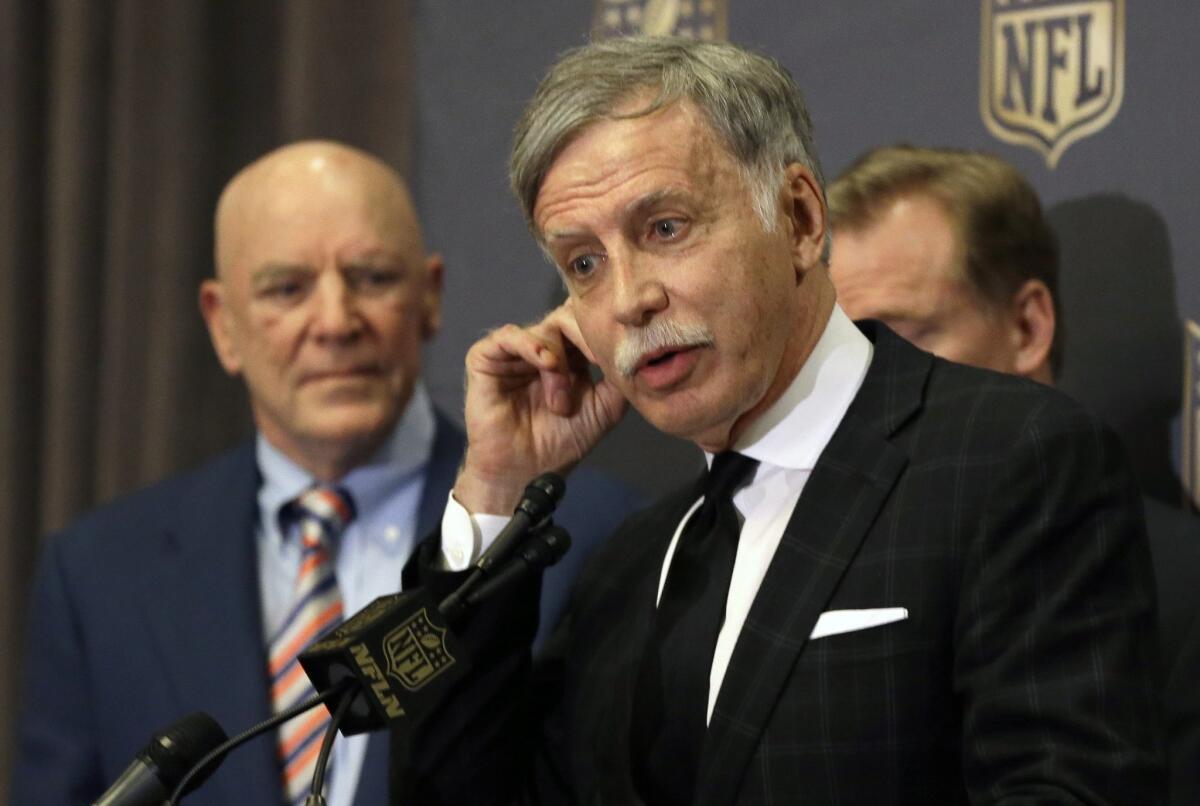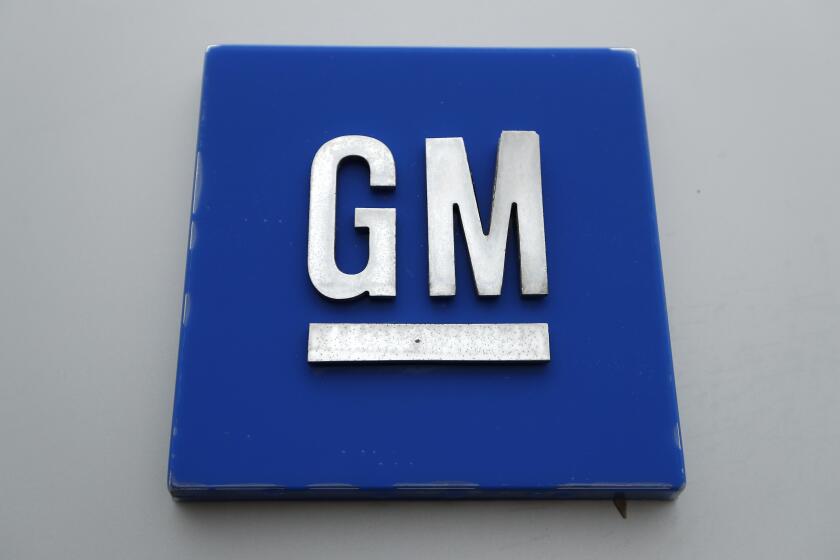Column: The NFL in L.A.: Inside the long con

Savior or profiteer? St. Louis Rams owner Stan Kroenke, after gaining NFL permission to relocate his team to Los Angeles.
- Share via
The billionaire’s club known as the National Football League is returning a team to Los Angeles after more than two decades.
We in the community are supposed to be delighted at the prospect of the St. Louis Rams relocating to L.A., a community the team abandoned after the 1994 season. Local football fans will have the opportunity, denied them for all those years, to brave traffic jams so they can witness in person a team that can be followed from the comfort of their own homes -- assuming they can afford the tickets or gain luxury-box access in the team’s new “privately financed” stadium, which is priced at more than $2 billion.
Will Los Angeles -- or more specifically, the small city of Inglewood -- be happy with the NFL as a partner? Let’s look at the long, discreditable record.
According to my colleagues Sam Farmer and Nathan Fenno, Rams owner Stan Kroenke got teary-eyed the other day when discussing the wrenching emotional toll of moving his team halfway across the country to its new home. “I never dreamed I’d be put in this position,” he said, calling himself a “victim” of circumstances.
This is the sort of thing you say when you’re blindsided by an act of God, as when a meteor comes crashing out of the sky and destroys your neighborhood. The truth is that the decision to move the Rams out of St. Louis was 100% under Kroenke’s control. St. Louis and Missouri officials moved heaven and earth to keep Kroenke in St. Louis, offering more than $400 million in public assistance to build a new stadium. By November, when plans for the relocation were well under way, Kroenke had met only once with Missouri Gov. Jay Nixon and never with St. Louis Mayor Francis Slay. “I have tried, as has the governor and others in St. Louis, to engage the Rams without success,” Slay said.
Will Kroenke be the kind of pro sports owner who garners the respect and devotion of the fans by delivering winning teams, like the NBA Lakers’ Jerry Buss, or a detested profiteer like the former owner of the NBA Clippers, Donald Sterling? My colleague Bill Plaschke says Kroenke better emulate the former, or else, because L.A. likes champions: “You must win. You must entertain. You must do both with ... decency and integrity.”
But St. Louis likes champions, too. Kroenke never seemed deeply moved by the mandate. He acquired a large minority holding in the Rams in 1995 to help finance their move to St. Louis, (imagine that), then bought the rest in 2010. Since 1995, the Rams have posted a win-loss record of 142-192, or .424. Since 2010, under his full ownership, the team record is even worse, 36-59, or .379. The team hasn’t been in the playoffs since 2004 and regularly makes it onto lists of the worst teams of the 21st century.
One thing the NFL does very well is maintaining a competitive balance between its big-market teams and smaller teams. At the moment, the list of teams in playoff contention include franchises representing Kansas City and Green Bay, while those from the big cities of New York, Chicago, and Washington, D.C., are gone. Will Kroenke really have to field a winning team to make it in L.A.? It’s doubtful; like his fellow owners, he can continue to collect millions in profits and potential capital gains by fielding mediocrity.
The feature of this deal that should really give taxpayers pause is the assertion that the new stadium will be entirely privately financed. As I reported last February, when the Inglewood stadium first took on the glint of reality, that’s simply not so.
According to the development plan that was slapped together for the Inglewood City Council with suspect haste last year, taxpayers will be on the hook for unspecified “public services and infrastructure.” Some gains expected by the city from stadium operations will be eaten away by the cost of traffic control and police and fire protection for game attendees, which the city will cover from its share of revenues.
It would be lovely to have more details, but they’re not forthcoming because the City Council voted to exempt the project from the California Environmental Quality Act, which demands facts and figures. There won’t be a new environmental impact study, either.
Nor willInglewood residents get a vote on the deal, because the City Council blocked that, too. How come? It’s possible that the council members were swayed by the more than $118,000 in campaign contributions made since 2006 by the development firm building the stadium and an associated retail and residential complex. Political corruption, by the way, is also a taxpayer cost.
For some reason, Inglewood officials have been blinded to the NFL’s dismal record as a corporate citizen in the communities hosting its franchises. St.Louis is a great example. As of a year ago, the taxpayers still owed $129 million on the bonds floated to finance the Edward Jones Dome, built for the Rams in 1995 -- that’s an annual financing bill of $12 million to the state, and $6 million each to the city and county of St. Louis. In return, the Rams have been paying direct rent of $250,000 a year.
Then there’s San Diego, which hosts the NFL Chargers in the publicly owned Qualcomm Stadium. The Chargers have long been agitating to flee to the Los Angeles market. The league has given the team a one-year option to join the Rams in Inglewood.
Just as St. Louis officials have accused Kroenke of not dealing with them candidly (there’s that “decency and integrity” issue again), San Diego has found Chargers owner Dean Spanos cool to its offer of more than $350 million in public funds for a new stadium. The city still owes more than $50 million on a Qualcomm renovation it financed in the mid-1990s -- an annual bill of nearly $5 million a year to the cash-strapped municipality. According to the Chargers’ lease, if the team leaves at any time in the next year, it would owe a termination fee of at least $12.8 million. But that wouldn’t be enough to retire the outstanding debt.
Much is being said about the Inglewood stadium’s state-of-the-art design. If Inglewood thinks that makes the stadium future-proof, it should think again. Almost every stadium built for an NFL team is declared to be state-of-the-art upon its opening, but it isn’t long before it’s being decried as the next thing to a slum by team owners and league officials demanding a new arena or costly renovations.
The Jones Dome was just such a marvel when it was built in 1995, but by 2008 it was ranked by fans as the worst in the NFL and still one of the worst in 2012, even after renovations in 2009 and 2010. That became a real problem for St. Louis, as the Rams lease states that the stadium must rank among the top tier of NFL arenas in 2015 or the team could break the lease -- perhaps the most astonishing giveaway in the original deal luring the team from Los Angeles.
Inglewood may believe that it has secured a place as a major league city for all time, but memories are short, and the National Football League is expert at putting a gun to muncipalities’ heads. Within a decade or so, you can expect the Rams and the league to start complaining about the stadium’s outdated facilities and demanding public concessions.
As the largest community in the country without an NFL team, Los Angeles has been wielded by the league as a threat to other NFL cities judged too stingy with taxpayer subsidies.
Is that threat now ended? Not by a long shot. If Inglewood doesn’t give the NFL what it wants in the future, there are plenty of alternatives within an hour’s drive of LAX, all of which have received at least a preliminary going-over by league officials -- Carson, downtown Los Angeles, and the City of Industry all had projects that looked inviting enough. Ten or 20 years from now, at least some of them will still be alive, looming as a threat to Inglewood. With the NFL, the con game never ends.
Keep up to date with Michael Hiltzik. Follow @hiltzikm on Twitter, see our Facebook page, or email [email protected].
More to Read
Inside the business of entertainment
The Wide Shot brings you news, analysis and insights on everything from streaming wars to production — and what it all means for the future.
You may occasionally receive promotional content from the Los Angeles Times.











